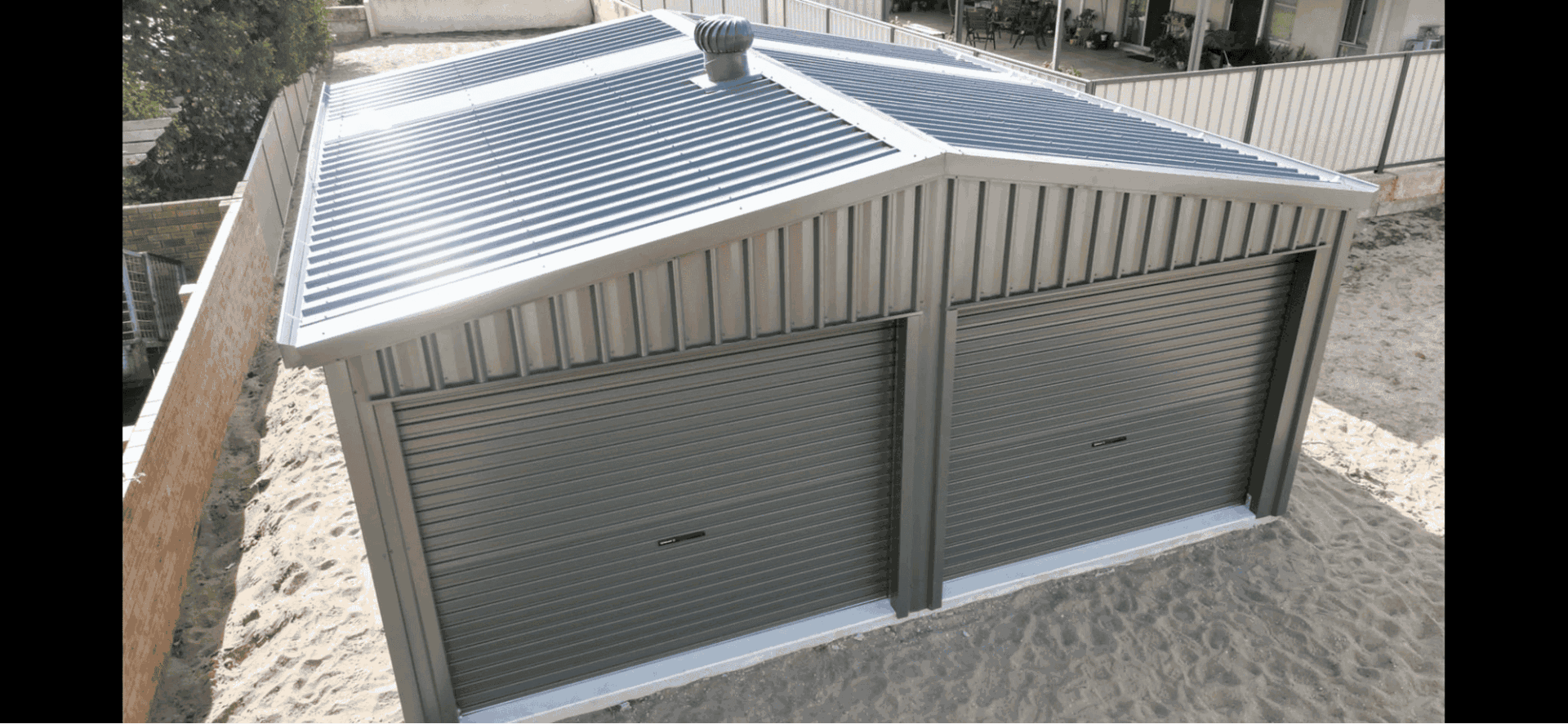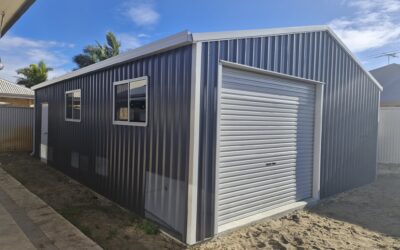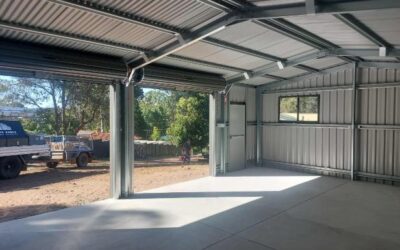How to Weatherproof a Shed (The Right Way)
With the diverse and often harsh Australian climate, it’s important to ensure that your shed can withstand everything from scorching sun to torrential rains. At Spinifex Sheds, we don’t just slap together sheds—we build them right. With top-quality materials and expert craftsmanship, we make sure your shed is weatherproof, durable, and made to last. Here’s how to do it properly, with the right team on the job.
Understanding weather challenges for steel sheds
Owning a steel shed in Australia means preparing for a variety of weather conditions, bringing its fair share of challenges. If you want your shed to stand the test of time, you need to plan for these conditions:
Rust and corrosion: Steel and moisture don’t mix. If water hangs around too long, rust sets in. That’s not just ugly—it weakens the steel, putting your shed’s strength at risk. Rust is not only unsightly, but it also weakens the steel, compromising the structural integrity of the shed.
Temperature fluctuations: Ever noticed how metal gets scorching hot in summer and freezing cold in winter? That’s steel for you—it expands and contracts with temperature changes. If your shed’s not built right, this can mess with door alignment and moving parts. A well-designed shed, built by pros, takes this into account with proper allowances and ventilation.
Condensation: Big temperature differences between day and night can cause condensation inside your shed, like a cold beer bottle sweating on a hot day. Left unchecked, it can lead to rust, damage stored gear, and create a breeding ground for mould. Good airflow, insulation, and ventilation make all the difference.
Wind damage: Perth’s no stranger to howling winds, and if your shed’s not anchored properly, you could be in trouble. Cheap, lightweight sheds can get battered, dented, or worse—ripped apart. That’s why a solid foundation, heavy-duty fixings, and a properly engineered design are non-negotiable.
Water damage: If water pools around your shed’s base, you’ve got a problem. Over time, that standing water eats away at the steel, especially down low where it can go unnoticed. Smart drainage, proper site prep, and good design keep your shed dry and solid.
UV exposure: The Aussie sun is brutal—paint fades, cracks, and peels if it’s not up to scratch, leaving your shed exposed to rust. That’s why we use high-quality COLORBOND® steel, built to handle the heat and keep looking sharp for decades.
1. Choosing the right materials
When it comes to building a shed that stands up to Australia’s harsh climate, picking the right materials is a no-brainer. You want something tough enough to handle rust, corrosion, and the blazing sun without giving up after a few years. That’s where COLORBOND® and ZINCALUME® steel come in.
COLORBOND® Steel – Built to Last
COLORBOND? features a core of high-quality steel, coated with a mix of aluminium, zinc, and magnesium for enhanced corrosion resistance. It doesn’t chip, flake, or blister under extreme weather, so your shed stays looking sharp for years. Plus, with a range of colours, you get both durability and style.
ZINCALUME® Steel – Strength and Efficiency
ZINCALUME? is another excellent choice with its blend of aluminium, zinc, and silicon which forms a protective barrier against the elements. It also does a great job of reflecting heat, helping to keep the shed’s interior cooler—perfect for those scorching Aussie summers. And if you’re after a cost-effective option that doesn’t skimp on strength, ZINCALUME® delivers.
Not sure which one’s best for your shed? Check out our COLORBOND® vs. ZINCALUME® comparison to help you decide. Either way, with Spinifex Sheds, you’re getting top-quality steel that’s built to handle whatever the Aussie climate throws at it.
2. Using effective insulation techniques
If you want to keep your shed comfortable year-round—whether you’re working on the ute, tackling a project, or just kicking back—you need proper insulation. A well-insulated shed stays cooler in summer, warmer in winter, and keeps condensation in check. Here are the best insulation options for Aussie sheds.
Fibreglass insulation: Commonly used in homes, fibreglass batts or rolls can be effective for steel sheds too. They are ideal for temperature control and are relatively easy to install. However, it’s important to ensure that the fibreglass is completely covered to avoid irritation or health hazards.
Reflective foil insulation: This type of insulation is particularly effective in hot, sunny climates. It reflects radiant heat, keeping the shed cooler in summer. It’s lightweight, easy to install, and can be used in conjunction with other insulation types.
Want to know more about choosing and installing the best insulation for your shed? Check out our How to Insulate Your Shed guide. Whatever you’re using your shed for, proper insulation makes a world of difference.
3. Implementing proper ventilation
Proper ventilation in steel sheds is vital for preventing condensation, moisture buildup, and the subsequent issues of rust and mildew. Here are a few ways to ensure your shed has the ventilation it needs.
Passive Ventilation – Let the Airflow Do the Work
This type of ventilation relies on natural airflow to keep your shed fresh, with no need for power.
- Doors and windows: Installing these on opposite sides of the shed allows for cross-ventilation. One draws in the fresh air while the other expels stale air.
- Louvre vents: These are adjustable and can be opened or closed as needed, providing control over the amount of ventilation.
- Whirlybirds: These are often powered by the wind, but you can get electrical ones too. They remove hot air from the top of the shed, allowing cooler air to enter from lower vents.
Active Ventilation – When You Need More Airflow
For bigger sheds or extreme climates, powered ventilation systems can step in to keep the air moving.
- Exhaust fans: These can be installed to expel hot or humid air from the shed, especially useful in workshops or sheds housing heat-generating equipment.
- Thermostatically controlled fans: These fans turn on automatically when the temperature inside the shed reaches a certain level, ensuring consistent air movement.
Want to make sure your shed stays cool, dry, and rust-free? Check out our Guide on Shed Ventilation for more tips on the best ventilation setup for your space.
4. Building for wind resistance
If you’re in a windy part of Australia, a flimsy shed won’t cut it. Strong gusts can batter poorly built sheds, causing damage or even ripping them apart. That’s why a wind-resistant shed isn’t just a good idea—it’s essential. Here’s how to make sure yours can handle the toughest conditions.
Design & Materials – Strength Where It Counts
Aerodynamic designs help reduce wind pressure, and using high-quality, heavy-duty steel like COLORBOND® or ZINCALUME® makes a big difference. These materials are built tough and rated for Aussie conditions, so you know they’ll stand the test of time.
Foundation & Anchoring – Solid as a Rock
A shed is only as strong as what it’s sitting on. The best way to keep your shed secure is anchoring it to a concrete slab foundation. This gives it a rock-solid base that won’t budge when the wind picks up. Want to know why a concrete slab is the best option? Check out our blog on Concrete Slabs.
Doors & Windows – Built to Handle the Pressure
Wind isn’t just hitting the walls—it’s pushing against your doors and windows too. That’s why they need to be reinforced with strong frames and heavy-duty hardware. In high-wind areas, skimping on these details can lead to leaks, warping, or even blown-out doors.
If you’re building in a windy region, make sure your shed meets the right wind rating for your area. For more info on Australia’s wind zones and what they mean for your shed, check out our Shed Wind Ratings Guide. When it comes to wind, don’t take chances—build it right, and your shed will stand strong for decades.
5. Protecting against water damage
Water damage is one of the biggest threats to a steel shed. If you don’t manage water properly, you could end up with rust, rot, and mould—none of which you want anywhere near your gear. Here’s how to keep your shed high and dry.
- Proper shed placement: Location is everything. Avoid setting up your shed in a low-lying area where water collects. Instead, choose a spot with natural drainage so rainwater flows away, not toward your shed.
- Quality roofing material: A good roof is your shed’s first line of defence. COLORBOND® and ZINCALUME® steel roofing are top choices because they’re tough, water-resistant, and built for Aussie weather. Just make sure it’s installed and sealed properly to prevent leaks.
- Gutters and downspouts: A solid gutter and downspout system channels rainwater off the roof and away from your shed’s base, stopping water from pooling around it. Wondering if your shed needs gutters? Check out our blog on Do Sheds Need Gutters?
- Effective ground drainage: Make sure the area slopes away from your shed, so water naturally drains away instead of sitting and soaking into the foundation. If your ground’s flat, consider adding drainage trenches or gravel to improve runoff.
- Elevated foundation: For extra protection, raise your shed on a concrete slab or an elevated platform. This keeps water from creeping in during heavy rain or minor flooding, protecting the structure and everything inside
Why have your shed professionally built?
Sure, you could try to put up a shed yourself, but if you want something that’s built to last, designed for your specific needs, and tough enough to handle Aussie weather, getting it professionally built is the way to go. A properly built shed isn’t just a storage space—it’s an investment.
Build a weatherproof shed with Spinifex Sheds
At Spinifex Sheds, we don’t do flimsy, off-the-shelf shed kits. We build custom steel sheds, designed to handle the harshest conditions and tailored to fit exactly what you need.
Using 3D design technology, we create precise blueprints for your shed before construction even begins, ensuring every detail is spot-on. But we don’t just stop at putting up four walls and a roof—we go the extra mile to weatherproof your shed, making sure it stands strong against wind, rain, heat, and everything in between.
Whether we handle it directly or collaborate with trusted specialists, we ensure that every weatherproofing job is done right, protecting your investment against harsh weather conditions.
We also handle all the necessary paperwork and liaise with the city council on your behalf, ensuring that every aspect of your shed project complies with local regulations and standards.
Ready to start your shed project with a team that does it all? Contact us today to talk about your shed project or to request a FREE quote!
Similar Articles
Man Shed Ideas: Turn Your Shed Into a Personal Escape
A shed’s never just a box with a door. It’s where you stash the gear, sort your tools, or line up your next project. Whether you’re fixing the ute, catching the footy, or just want a spot to disappear for a bit, the right setup makes all the difference. Even if it’s just for storage, it should still be tough, weatherproof, and built to last.
How to Keep a Shed Cool in Summer
If you’ve spent a summer working out of a steel shed in the WA heat, you know how fast it can turn into a sweatbox. Whether you’re parking gear, storing feed or knocking out a few jobs in the shade, the last thing you want is to step into an oven every time you open the roller door
How to Build a Machinery Farm Shed (Properly)
Machinery is the backbone of any farm. Tractors, headers, sprayers, seeders. These are big investments that keep everything moving. Leaving them out in the weather or under a flimsy shed leads to rust, costly repairs, and downtime when you least need it.









